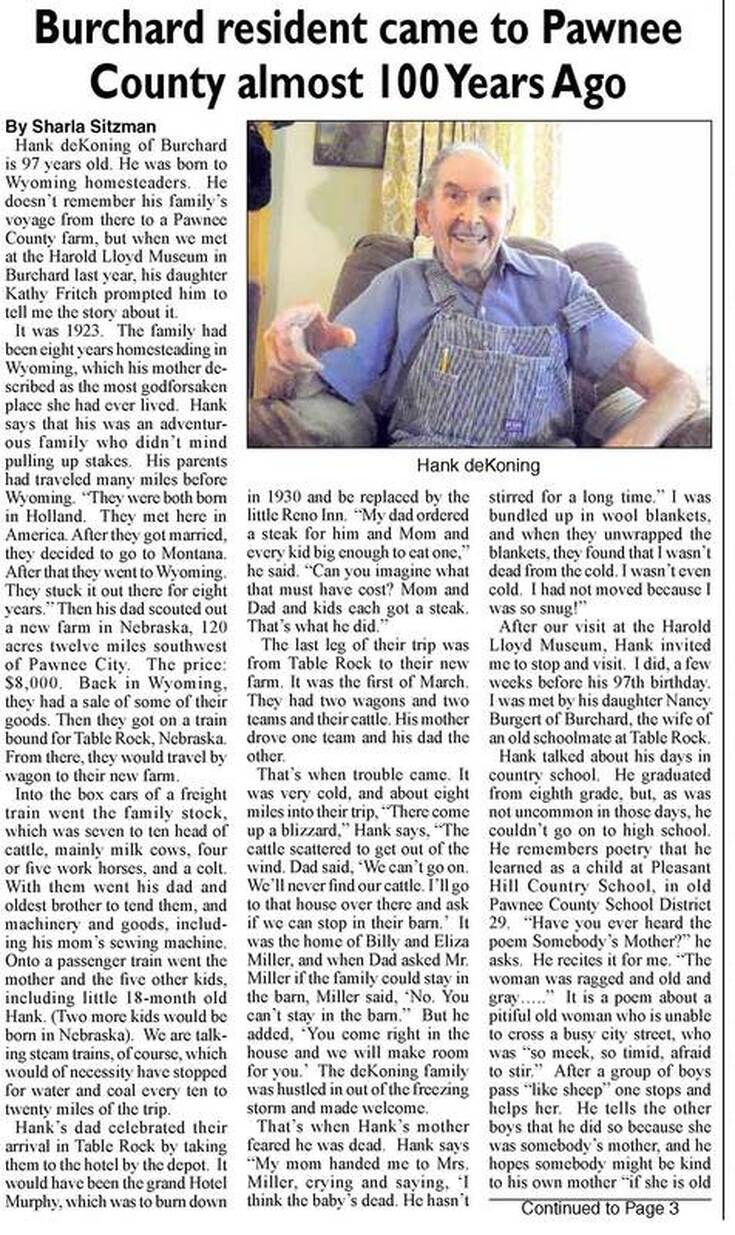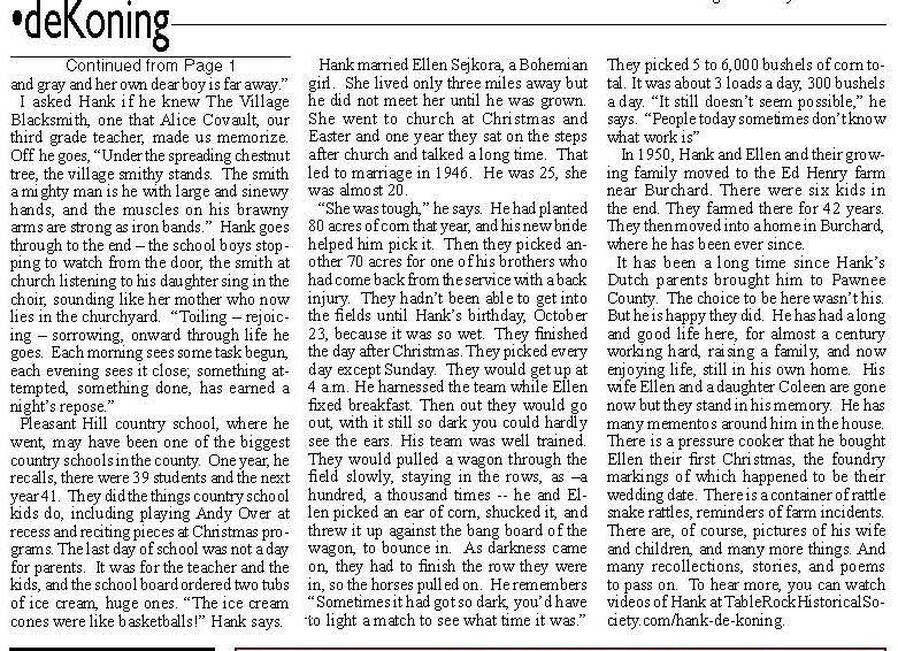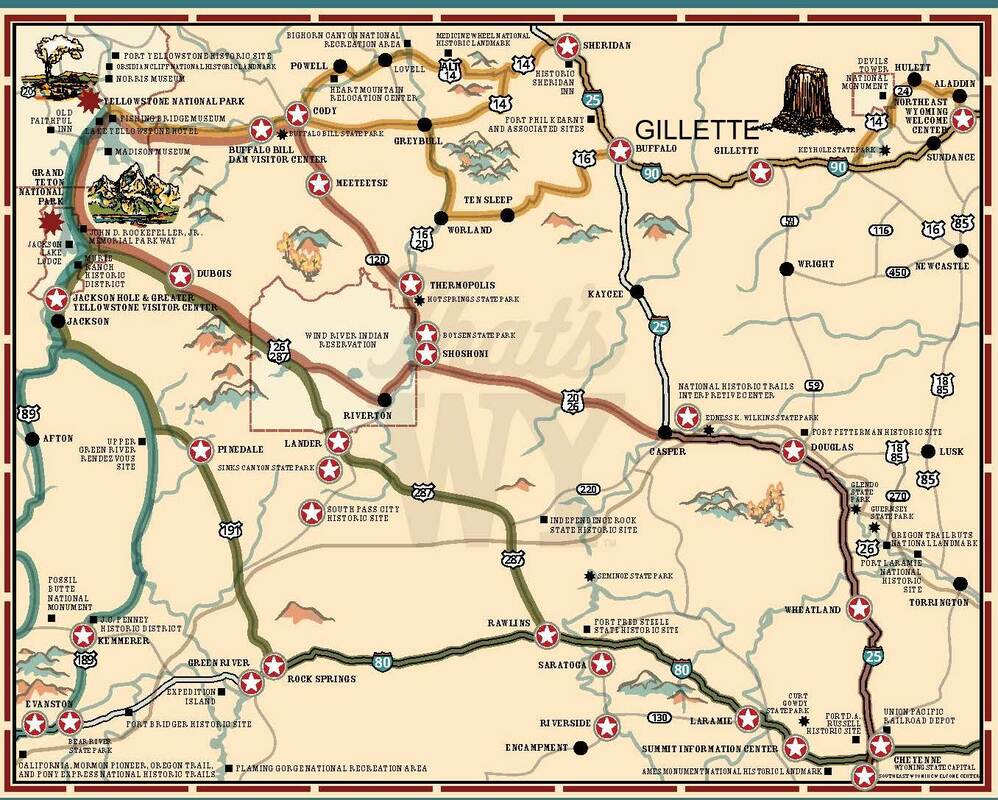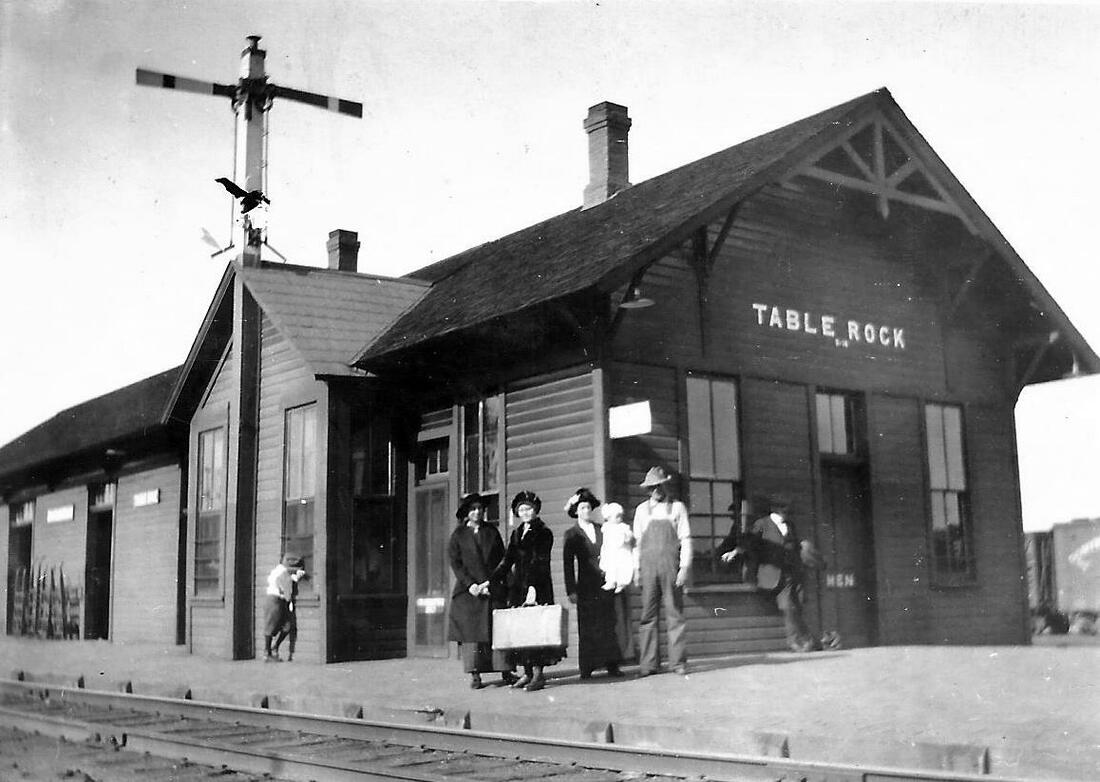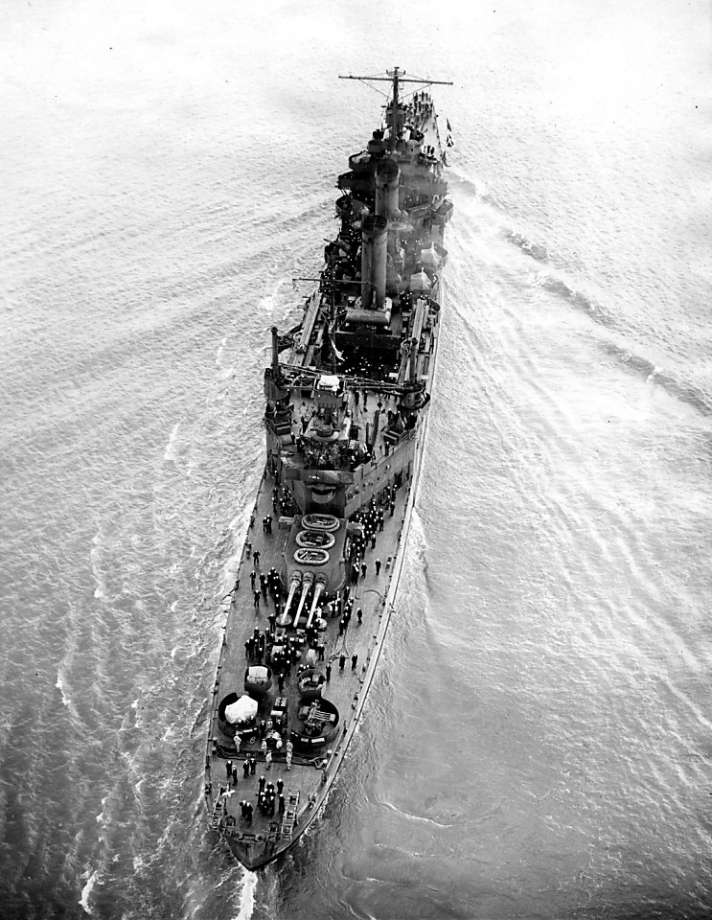hank de koning: His stories
HE arrived in pawnee county almost a century ago.
below: photos, AN ARTICLE IN THE REPUBLICAN, videos, & a then FABULOUS personal history penned by hank HIMSELF, GIVING DETAILS OF FARMING IN THE 1930S & 1940s, MUCH OF IT YEAR-BY-YEAR
hank -- a man with table rock connections
Hank de Koning spent most of his growing up years on a farm southwest of Pawnee City, then himself farmed near Burchard for 42 years. Table Rock has a bit of a claim on him, though. When he arrived in Pawnee County in 1923, it was on voyage by steam train that ended at the Table Rock depot. Two of his daughters, Nancy and Kathy, married Table Rock boys. Nancy married Richard Burgert, Class of 1972, and Kathy married Don Fritch, Class of 1981. And his daughter Coleen was a popular teacher at Table Rock in the early 1970s. She taught 5th grade for the year 1971-1972. So this is Hank's story, as best we can tell it.
AN ARTICLE IN THE PAWNEE REPUBLICAN
From the Pawnee Republican, February 14, 2019
CHATTING WITH HANK IN OCTOBER 2018
HANK'S OWN STORY
|
THE LIFE AND TIMES OF
HENRY & ELLEN de KONING By Henry de Koning 2012 I was born on October 23, 1921 in a two-room house on the Wyoming prairie, on a homestead of one hundred and sixty acres. The nearest town was Gillette and was 23 miles away. The Devil’s Tower, one of Wyoming’s tourist attractions, was 90 miles away. My father said you could see it on a clear day. My parents spent eight years there. The winters were cold and hard. Dad built a cattle shack that had a kind of knot hole on the north side and during a blizzard there drifted enough snow into the shed to half fill it with snow. The fuel they used was cow chips and coal. The coal was surface coal, not the best but sufficient to heat the house. The homestead is now part of the coal mine that brings trains with 100+ cars of coal to many Midwest states. I think my dad could have stuck it out, but Mother was not happy there. They saw an ad in the paper for a 120-acre farm for sale in Nebraska. Dad boarded a train and went to look at the farm. The man that owned the farm was about to lose it so Dad traded the homestead and took over an $8,000 mortgage. The year was 1923. They had a farm sale. And we were Nebraska bound. We brought with us 7 or 8 cows that were dual purpose cows, mostly milk cows, four head of mustang work horses, a McCormick-Deering five-point mowing machine, and my mother’s sewing machine. Dad and my oldest brother Neal rode on the freight train to take care of the livestock, and mother and five children came on the passenger train, I being the youngest at 1-1/2 years. We landed at Pawnee City around March first and headed for our new home that was 12 miles away, in the late afternoon, hoping to make it before dark. We had gone eight miles when a blizzard came up. Dad was driving one team and wagon. Mom was driving the other. Driving the cattle ahead of us. When the storm hit the cattle scattered to get out of the wind. So Dad said we can’t go on and leave the cattle there. We were right by a farm occupied by Billy and Liza Miller, who also had 7 or 8 children. Dad said, I’m going to ask them if we could sleep in the barn. Billy said, no, you bring the family in the house and we’ll make do. I was in Mom’s wagon. She was holding me between her knees and driving the team. She told Mrs. Miller, I think the baby is dead. I hadn’t stirred for some time. They laid me on the bed and threw off the blankets and I was laying there smiling at them. The next morning the storm was over and the sun was shining. To get out of the storm, the cattle had come in on the porch, which was on the east side of the house. They made a big mess. The porch had a concrete floor so it didn’t tear anything up but Dad was so embarrassed and sorry. But Billy said don’t worry, we’ll get a shovel and some water and it will be as good as new. The next 4 to 5 years was better. We raised good crops and things were really looking up. Then came 1934, one of the worst drought years in history. The corn Dad planted got little over waist high and tasseled out. Dad took a horse mower with a five-foot bar and mowed two rows at a time, then he took a dump rake and raked it into piles, which was some of the next winter feed. We had probably 40 to 50 head of cattle. So dad culled down to 14 head of milk cows. The farm had probably 40 acres of big timber and we would cut down 2 or 3 big elm trees a day so the cows could eat the leaves. In those days, chainsaws were unheard of so we used an ax and a tree man’s crosscut saw. I remember well as I was on one end of the saw. Then for the next five or 6 years we cleaned up the trees we had cut for the cows. People would come out from Pawnee City for firewood. The price was $1.00 a rick. The measurement of a rick was 16” wide by 4 feet high and 8 feet long. About a half-ton pickup load. We didn’t get rich, but we survived. About the first part of 1934 it started to rain so we planted some wheat and had good wheat pasture the rest of that year. Then came 1935. It was the exact opposite. It was wet. Dad got the corn planted, and I remember him trying to cultivate it and the ground was muddy. So then we had grass, but again not much crop. The winter of 1935 and 1936, we had lots of snow, drifts of snow six to nine feet deep, and sub-zero temperatures. The temperature didn’t get above zero for the whole month of February. We probably had 12 of 15 cats. When spring came, we had one cat left and its ears were frozen off. But again we survived. In the Fall of 1935, there was an epidemic of sleeping sickness in many of the work horses and we lost 2 or 3 horses. So Dad decided to buy a tractor. He could buy an F-20 Farmall for $835 or a W. C. Allis Chalmers for $725.00. He chose to buy the Farmall. It was used only in the spring, summer, and Fall. In the winter, it was put in the shed till spring. The year 1937 was some better. Dad had planted everything to wheat, 112 acres. The 1937 crop of wheat was cut with a binder. Brother John drove the tractor and dad rode the binder so I and sister Minnie and Brother Rich shocked the 112 acres of wheat. When they were done cutting, we were nearly done shocking. The shocks were set up with cut-end down and the drain end up. Was left in the field for 3 to 4 weeks to cure, then the threshing crew would come in and the bundles were pitched in the machine. 6 or 7 neighbors who would help each other till all had their grain in the bin was called the threshing crew. The machine was powered by a steam engine. In 1938, the same acres were planted to wheat but Dad bought an Allis Chalmers combine. It was called an All Crop Harvester No. 60. It would cut a swathe of five feet. Brothers Neal and John would take turns driving the tractor. We would park two wagons at the end of the field. We would fill the wagons and then call a trucker by the name of John Price who lived south of Pawnee. By the time he got there they had another bin load on the combine. They would dump the load in his truck and scoop the two wagon loads in the truck and he was ready to haul it to Liberty, Nebraska. The wheat crop that year averaged 16 bushels per acre and brought $1.25 per bushel. Dad thought he had the world by the tail, as it would pay for an acre of land that sold for $20.00 per acre. The grain was dry but the ground beneath was wet. The dead wheat straw would shade the ground and not let the dirt dry. As a result, they got stuck many times. We had a second tractor at the end of the field as a stand by. When they got stuck, they would wave their cap, which meant bring the tractor and give me a pull. 1939 was an average year, as was 1940, then came 1941. The war was raging in Europe and in December 1941 we were called into another conflict with Japan. Brother Neal was the first to be called. He served 37 months in the European theater. He was a mechanic and went until the Armistice was signed in 1945. Then there was brother Rich. He was working at the packing house in Omaha. He went into the Navy and served on the battle ship San Francisco. One day they were in a battle with the Japs. The skipper in charge told him to go below and get more ammunition. His gun was just a few feet from the steps. When he returned, the back end of his gun was completely gone, but he never received a scratch. Then a few months later, brother John was called. He went into the Air Corps, and was stationed in Puerto Rico on the ground crew. Each night as I went to bed, I prayed for each one and for all the boys and girls serving our country. It must have worked, as my brothers came through without a scratch. Many were not so fortunate. As Abe Lincoln said, they gave their last full measure of devotion. This brings us up to the Fall of 1945 and the Spring of 1946. Brother Neal was able to plant 70 acres of corn and take care of it that growing season, but when Fall came, he was unable to harvest the crop, as he had a slipped disc in his back. I had planted 80 acres on the home place. In the meantime, I acquired a wife. We were married on June 2, 1946 and are still going strong. This year, 2012, we celebrated 66 years. It was wet that Fall and we didn’t get started picking by hand till the 23rd of October. We worked from daylight till dark and we picked every day except Sundays, and finished the day after Christmas. Ellen stayed right along side of me and she never missed a day. Pretty good for a tough little Bohemian. When all was said and done, we had picked my 80 acres and when we finished we picked 70 acres for my brother Neal, 150 acres in all. What a honeymoon that was! It didn’t hurt us at all. It just toughened us in for the years ahead. In those days, if you had 40 bushels per acre you were doing well as we had no fertilizer or chemicals. (By the way, I scooped all the corn by hand.) The next year, we rented a farm from John Bookwalter, 1947. The year was dry but again we survived. Then came 1948. This was a real good year and we had a good wheat crop, also a good corn crop. We raised 32 butcher hogs. We butchered one and sold the other 1. Our check was $1,675.00 and seemed like a gold mine. |
The de Koning family homestead was 23 miles out of Gillette, Wyoming and about 90 miles from Devil's Tower. You can see both to the top right of this map of Wyoming. The "tree stump" is supposed to be Devil's Tower.
In 1923, the family traveled by steam train. In 2019, one would drive the Interstates and the trip would be 750 miles. The family traveled by train to Table Rock, then took hooked up two teams to wagons, one driven by Hank's dad, the other by his mom. This is the Table Rock depot at which they would have arrived. Bill & Liza Miller are buried in Akron, Colorado. Here is their tombstone as it appears on FindaGrave.com. With the 1934 drought, Hank's dad had to cut the corn down so it could at least be used for feed for the stock. He used a horse mower. If he used the McCormick-Deering mower he had brought from Wyoming, here's an example of what it may have looked like. Cutting down a tree with an ax & a cross cut saw? Here's how. The fellow goes out with a chainsaw then returns to get a cross cut saw instead, starting at 2:51: In 1936, Hank's Dad bought a Farmall F-20 tractor for $835. Here is a video showing A 1936 Farmall F-20 tractor being started, with its hand crank. In 1937, Hank's Dad cut the wheat with a binder, and Hank, a brother, and a sister, put it in shocks to cure for a few weeks until it could be threshed. Here's how that may have been done:
In 1938, Hank's Dad bought an Allis Chalmers All Crop Harvester 60 because it would cut a five-foot swathe. Here's a video of an A-C All Crop Harvester at work:
Hank's brother Rich served in the Navy during World War II, on the USS San Francisco. In 1942, the ship played a key role at Guadalcanal, although we don't know whether Rich was aboard at that time. Here is the ship, though: Picking corn by hand -- Here's a video with close ups of what Hank and Ellen were doing. Didn't find one with a better view of the horses. |
hank & his "tough little bohemian" bride, in later years
Daughter Kathy de Koning Fritch shared this picture of Hank and Ellen in front of their zinnias. Kathy says, "They loved planting those Zinnia together. I don't know if they put manure on them, but I have never seen zinnia plants get that tall!"
a few more stories of growing up, by hank
|
FLOATING IN WATER WHERE WATER RARELY IS
Some of the things that happened when I was very young or before I was born was in Wyoming. We lived 23 miles from Gillette. Dad would go 2 or 3 times a year to pick up some groceries that we ordered from Sears & Roebuck. We would buy sugar and oatmeal which both would come in 100-pound bags. Also, Mom would order a half dozen brooms. As Dad was returning home once, a thunder storm came up, which was unusual in Wyoming. It was in the month of June. He could hear water running in a slough, which was normally dry, but the horses stayed on the trail (which took them into the water) as they knew the way home. The water was deep enough that it floated the wagon box off of the gear. Dad had no choice but to let go of the lines. The horses took the gear on across and went home and left Dad floating down the stream in the wagon box. He used a couple of brooms as oars and worked his way to the other side. He got hold of some sage brush and pulled the box out of the water. Dad had to walk home. I don’t know how far it was, maybe 3, 4, or 5 miles. They dried out the oatmeal and sugar. Mom said they had lumpy sugar for a long time. (P.S. I hope you are not too confused, but get the picture.) |
Mom's order for a half dozen brooms proves fortuitous What does the gear of an old horse-drawn wagon look like? Here are several kinds |
 Here's a timber rattler, from a story about a search for one spotted at Burchard Lake
Here's a timber rattler, from a story about a search for one spotted at Burchard Lake
RATTLESNAKES! (By Hank)
Another time in my young life was here in Nebraska. I was probably 7 to 10 years old. It was a Memorial Day and brother John said, “Let’s go to Johnson Creek Cemetery and look at the stones,” referring to the head stones.
As we were crossing the section, there was a ravine with limestone projecting out of the hill (as you see in the movies). There was a space of about 18 inches and you could look back 7 feet. John and I always carried a rifle, 22 caliber. I was thinking of trying to find a rabbit so I lay down on my stomach to look back in the space. I decided nothing was there. I dropped my eyes and right in front of me there lay a timber rattle snake, not more than 18” from my face, curled up, which I had failed to see. I didn’t panic, but slowly got on my feet and hollered at John. He came in with the rifle and shot the snake in the head. And then it started to rattle.
More snake stories. Another time, this was in the same section as the first story but a mile down the creek, brothers Neal and John and I were fishing in Johnson Creek. We fished till late in the afternoon. We were walking single file. First Neal, then John, then me. As I was walking, I heard a buzzing noise and I thought it was a locust. As I was parting the underbrush to locate the noise, there was a timber rattlesnake, probably trying to protect her young. I yelled at Neal. He came back and killed it with his cane pole.
Then, several years later, after Ellen and I were married, we rented a farm a mile south and am mile west of Bookwalter owned by John Bookwalter. I never encountered any there, although there were prairie rattle snakes in the area.
Then we moved to the Ed Henry farm 10 miles west of Pawnee City, which was known as The Rattlesnake Farm. There were many times I could have gotten bit. I didn’t fear them but I did respect them. (I told the family, if God could close the mouths of lions for Daniel, he could close the mouths of snakes for me.)
If you would like to download a transcription of the stories written by hank, click on this file:
| life_^0_times_of_henry_^0_ellen_de_koning^j_by_henry_de_koning.pdf | |
| File Size: | 94 kb |
| File Type: | |
hank & his family
From his daughter Kathy, here is the family that Hank & Ellen raised on the farm. In the front are Hank and Ellen with Coleen between them. In the back are Kathy, Terry, Gary, Allen, and Nancy. It was probably about 1982. They lost Coleen in 1984. Photo 6974, shared by Kathy de Koning Fritch.
